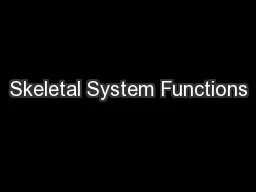

Support bones help support and provide shape to the body Protection provides protection to internal organs Mineral storage calcium and phosphorus make bones strong and help with oxygen Hemopoiesis ID: 409246
Download Presentation The PPT/PDF document "Skeletal System Functions" is the property of its rightful owner. Permission is granted to download and print the materials on this web site for personal, non-commercial use only, and to display it on your personal computer provided you do not modify the materials and that you retain all copyright notices contained in the materials. By downloading content from our website, you accept the terms of this agreement.
Slide1
Skeletal System Functions
Support: bones help support and provide shape to the body
Protection: provides protection to internal organs
Mineral storage: calcium and phosphorus make bones strong and help with oxygen
Hemopoiesis
: blood cell formation that occurs in the red bone marrowSlide2
Cont.
Movement: anchors muscle and helps move limbs
Pronation-turn downward or backward
Supination- to turn forward or upward
Flexion- decreases the angle between two bones
Extension-increasing the angle between two bonesSlide3
Rotation-movement around one central axis
Abduction-movement away from the midline of the body
Adduction-toward the midline
Circumduction- circular movement at a jointSlide4Slide5
Skeletal System Disorders
Arthritis: inflammation of the joints
2 types
Osteoarthritis- most common joint disorder, cause from aging wear and tear, symptoms are joint stiffness, tenderness, swelling, Rx is medication, lifestyle changesSlide6
Skeletal System Disorders
Rheumatoid arthritis- symptoms are stiffness, joint pain and loss of ROM, cause is unknown, Rx is to alleviate symptomsSlide7
Skeletal System Disorders
Gout: type of arthritis from high uric acid in joints
Symptoms- starts in big toes
, throbbing pain, swelling, tender, red
Cause- uric acid build up (diabetes, obesity, kidney disease)
Rx-ibuprofen, steroids, medication to reduce uric acidSlide8
Skeletal System Disorders
Osteoporosis: bones become weak and fragile, porous
Cause: low calcium, estrogen, steroid use
Rx: calcium, meds to make bone stronger, lifestyle changes,
Symp
: pain, shrinking, easy breaks Slide9
Skeletal System Disorders
Rickets is softening and weakening of the bones
Symp
: bone pain, tenderness, teeth
deformaties
Cause: vitamin D defeciency Rx- replace vitamin D, eat orangesSlide10
Skeletal System Disorders
Abnormal Spinal Curvatures
KYPHOSIS
– humped curvature in the thoracic area of the
spine “hunchback”
LORDOSIS – exaggerated inward curvature
in the lumbar region of the spine just above
the sacrum ”swayback”SCOLIOSIS – side to side or lateral curvature of the spineSlide11
Skeletal System Disorders
Kyphosis
Lordosis
ScoliosisSlide12
Skeletal System Disorders
Trauma's
Dislocation: bone is displaced from its proper position in a
joint
Strain
: overstretching
or tearing of a muscleFractures: bone break
Sprain: wrenching of a joint, causing a stretching or tearing of ligamentsSlide13
Fractures
Greenstick
: fracture common in children -
occurs when the bone
is
bent and splintered
but never completely separatesSimple: bone is broken but no skin is puncturedComminuted: bone is broken or splintered in many pieces embedded in surrounding tissue
Compound- most serious, broken bone protrudes through skinSlide14
Fractures Slide15
Fractures:
Rx:
Open reduction: surgical intervention with devices such as wires, metal plates or screws to hold the bone in alignment
Closed reduction: bone fragments are brought into alignment by manipulation and a cast or
splint is applied
Traction: pulling force is used to hold the bones
in place after a fracture